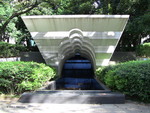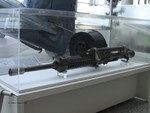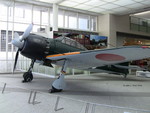Trip to Yasukuni Shrine and Yushukan Museum, 7 Sep 2009
Contributor: C. Peter Chen
 The Yasukuni Shrine, located in Tokyo, Japan, is a Shinto shrine dedicated to the spirits of those who died while fighting for Japan. Originally completed in 1869 to enshrine those who died in the Boshin War on the side of the Meiji Emperor, Yasukuni has since become a shrine for all those who died for other wars. It was formerly a state institution, but since the American occupation ordered the separation of church and state, it became an independent religious institution in 1946. Today, it enshrines 2,466,532 spirits. The shrine is controversial because 1,068 of those enshrined had been found guilty of war crimes; 14 of which were convicted Class A war criminals, such as Hideki Tojo, Iwane Matsui, Akira Muto, and Toshio Shiratori. Visits by politicians such as former Prime Minister Junichiro Koizumi only amplified the controversy.
The Yasukuni Shrine, located in Tokyo, Japan, is a Shinto shrine dedicated to the spirits of those who died while fighting for Japan. Originally completed in 1869 to enshrine those who died in the Boshin War on the side of the Meiji Emperor, Yasukuni has since become a shrine for all those who died for other wars. It was formerly a state institution, but since the American occupation ordered the separation of church and state, it became an independent religious institution in 1946. Today, it enshrines 2,466,532 spirits. The shrine is controversial because 1,068 of those enshrined had been found guilty of war crimes; 14 of which were convicted Class A war criminals, such as Hideki Tojo, Iwane Matsui, Akira Muto, and Toshio Shiratori. Visits by politicians such as former Prime Minister Junichiro Koizumi only amplified the controversy.
On the grounds of Yasukuni stands the Yushukan Museum, originally established in 1882 to preserve artifacts from the Meiji era Japanese Army. Near its entrance stood several statues, including a statue memorializing the 5,843 who died while performing special attacks, such as those who crashed their kamikaze aircraft into American naval vessels. This museum is also controversial like the Yasukuni Shrine. Japanese aggression committed against its neighbors are described as liberation from colonial powers, and the start of the Pacific War is said to be forced by Franklin Roosevelt's political maneuvering which left Japan little choice. Finally yet importantly, the museum downplays certain events that cast negative light on Japan. For example, the Battle of Nanjing and the subsequent Rape of Nanjing, during which somewhere between 50,000 and 300,000 Chinese were murdered en masse, was described in no more than a few sentences, with stress on that General Matsui ordered his troops to obey military rules of engagement. Some of the more positive aspects of the museum includes the display of war machines (a Zero fighter, a Type 97 tank, a Kaiten submarine, etc.), last letters written by military men, and entire walls of photos of those enshrined. A special exhibit dealt with athletes who served and died for Japan, including a large display on Colonel Takeichi Nishi who was recently made famous by the film "Letters from Iwo Jima".
When I visited, I tried to keep an open mind as much as I can. The Yasukuni Shrine's architecture was beautifully stunning, and as I happened to have caught a ritual ceremony (I am uncertain how often it is done), I felt that, although some of those enshrined were deemed war criminals, some of the martyrs indeed deserve remembrance. The Yushukan Museum started out to be extremely fascinating, with me carefully studying every curve of war machines on display and every photograph shown on the walls. However, as I read deeper into the text, I began to feel uneasy about how the museum whitewashes, and at times glorifies, Japanese aggression against her neighbors. Seeing that Japan's blatant violation of my native country's sovereignty (the Republic of China, now located on the island of Taiwan after losing the Civil War of the late 1940s) by installing a puppet government in Manchuria as liberation of the Manchu minority from Han Chinese made me feel uneasy. I also noticed that the translation of Japanese text into English seemed to be selective, and that made me feel suspicious whether the museum was attempting to veil certain things from foreigners who commanded less-than-perfect Japanese language skills. As I left the grounds of Yasukuni, I felt that the visit was highly enjoyable despite being uneasy about how certain parts of history were presented in a rather biased manner. I could not help but wonder whether German or Japanese visitors to an American museum on the topic of WW2 would share similar feelings I had while touring Yasukuni and Yushukan.
Last Major Update: Sep 2009
Photographs
 |  |  |  |
Trip to Yasukuni Shrine and Yushukan Museum, 7 Sep 2009 Mapa Interativo
Você gostou deste artigo ou achou este artigo útil? Se sim, considere nos apoiar no Patreon. Qualquer valor já vai ajudar! Obrigado. Por favor, ajude-nos a divulgar o site: Fique atualizado com WW2DB: |
Visitor Submitted Comments
2 Jan 2013 11:41:15 AM
Says a lot about the character of the japanese... Honoring war criminals and those responsible for numerous atrocities visited on POWS during WW2. To say nothing of the rape and death of civilians in various countries.
All visitor submitted comments are opinions of those making the submissions and do not reflect views of WW2DB.

- » Wreck of Teruzuki Found (27 jul 2025)
- » USS Orlean's Bow Found (22 jul 2025)
- » The Emperor of Japan Planned to Honor WW2-era Japanese POWs in Mongolia (4 jul 2025)
- » US State Lawmaker John Winter Caught Using Racial Slur "Jap" and Apologized (11 jun 2025)
- » US Government Plans to Purge WW2 Information (17 mar 2025)
- » Ver todas as notícias
 |
- » 1,182 biografias
- » 337 eventos
- » 45,119 entradas na linha do tempo
- » 1,249 navios
- » 350 modelos de aeronaves
- » 207 modelos de veículos
- » 376 modelos de armas
- » 123 documentos históricos
- » 261 instalações
- » 470 resenhas de livros
- » 28,415 fotos
- » 365 mapas
Lt. Gen. Lewis B. "Chesty" Puller, at Guadalcanal
Por favor, considere nos apoiar no Patreon. Mesmo R$1 por mês já faz uma grande diferença. Obrigado!
Ou, por favor, nos apoie adquirindo alguns produtos do WW2DB na TeeSpring. Obrigado!
29 Sep 2009 11:26:12 AM
I once took my son's Japanese Father-In-Law with me on a tour of the USS Arizona Memorial. He was very attentive during the tour but did not have any comments afterward.